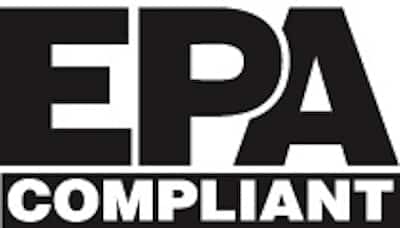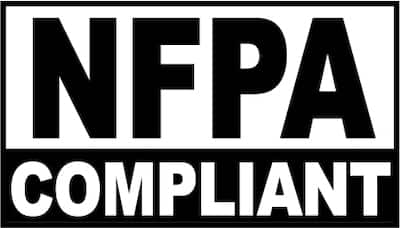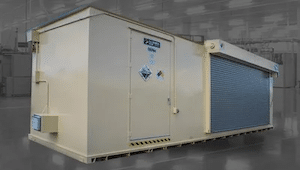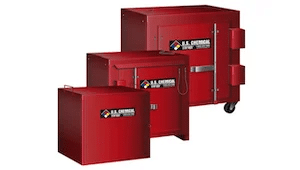Lighting
When working with hazardous materials, it is crucial to have durable, efficient lighting in each part of your chemical storage building. Every U.S. Chemical Storage lighting fixture is manufactured to guarantee visibility and safety.

*Explosion proof LED light
Lighting the Way
When working with hazardous materials, it is crucial to have durable, efficient lighting in each part of your chemical storage building. Every U.S. Chemical Storage lighting fixture is manufactured to guarantee visibility and safety. We offer a wide variety of explosion proof and non-explosion proof lighting options for storage buildings. Light fixture placement is based on chemical storage building size, mounting height of light fixture and photometrics measured in lumens per fixture. UL Listed and factory sealed fixtures meet requirements as follows:
- Class I, Div. 1 & 2, Groups C and D Class I, Zones 1 & 2, Groups llB, llA
- Class III, Div. 1 & 2
- Marine
- Class II, Div. 1 & 2, Groups E,F,G
- Suitable for wet locations
- NEMA 3, 4, 4X
Types of Lighting
Standard Pendant Type Fixtures
Standard pendant style light fixtures extend down from the ceiling. Chemical storage building height can be raised to accommodate these fixtures, or the light fixture can be relocated to corners or walls to avoid walking into it.
Linear Type Fixtures
Optional linear type light fixtures are available in both LED and fluorescent styles. Fixtures are mounted near the center of the ceiling and positioned to give fire suppression components center-ceiling priority. Rated for 20⁰ F and for cold weather starts, the ballast is thermally protected for temperatures down to 0⁰ F.
Emergency Chemical Storage Lighting
Battery backup emergency lighting is available for lighting an egress path when required by local regulations. Class 1&2, Division 1&2, options available.
Features & Benefits
- Compact factory assembled system
- Standard time delay- set for 5 seconds to 15 minutes
- Rugged NORYL thermoplastic luminaire heads
- View through window allows easy monitoring
- Intel-charge electronics
- Nonmetallic, enclosed and gasketed construction
- Exterior hardware- nylon, plastic coated, and stainless steel
- Cover gasket- Hypalon synthetic rubber
- UL Listed
Explosion Proof Lighting
U.S. Chemical Storage explosion proof interior lighting is made with sealed heavy-duty housing, a glass globe, and a protective metal guard. Corrosion-proof, water-resistant construction prevents sparks within the housing, dramatically reducing the risk of igniting dust, gases, vapors, or fibers in the air surrounding the fixture.
Non-Explosion Proof Lighting
Our non-explosion proof interior lights are encased in die-cast aluminum, silicone gaskets, and thermal shock resistant soda lime glass to prevent shattering and resist degrading in the presence of high temperatures. Built to strictly adhere to all regulations, these indoor incandescent fixtures set industry standards in compliance where explosion proof interior lighting is not required.
Features & Benefits
- Weather-resistant steel construction
- Chemical & UV resistant coating
- Can be manufactured to meet EPA, NFPA 30 and NFPA 1
- Continuously welded, leak-tested sump
- Walk-in or rack style available
- 15-year structural warranty
Common Applications
- Hazardous Waste Storage
- Flammable and Combustible Storage
- Paint and solvent Storage
Downloadable Information & Fact Sheets
- Drawing: 2-Hour Bi-Direction Fire Rated Building (FL6115)
- Design Your Explosive Storage Magazine
- Warranty on Building & Accessories
- Buy or Build Chemical Storage Brochure
- Infographic: Choosing a Chemical Storage Building
- FireLoc 1-page Sheet
Compliance & Approvals
At U.S. Chemical Storage we strive to give you the best solution for your operations. This building and its accompanying accessories can be engineered to meet the following approvals and certifications based upon your unique set of needs.




Frequently Asked Questions
First consult the Safety Data Sheet (SDS) to determine the type of chemical you’re storing and any storage requirements listed. There are two main classifications of buildings to consider: fire-rated and non-fire-rated steel buildings.
There are three main questions you should answer before engineering or design can begin on your building: what is to be stored, how much of it is being stored, and where is the location it will be stored? You will also need to consult with your local “Authority Having Jurisdiction” (AHJ) or local code expert to determine your area’s specific storage building requirements.
Our team at U.S. Chemical Storage has a wealth of knowledge, experience, and resources to help analyze your storage needs, but the final approval is made by the local AHJ, so you will need to ultimately ask them about your requirements early in the planning process.
The definition of a “sump” is a pit or reservoir providing containment for spilled liquids. U.S. Chemical Storage offers leak-proof spill containment sumps in each standard model. All our sumps are tested for leaks for a 24-hour period prior to finishing. The sump is then covered by a steel or fiberglass floor grating and can even be equipped with a resistant plastic sump liner to protect against corrosive chemical accidental spills. The size of the sump is dictated by code based on the volume of liquid being stored within the building.
Building size is determined by the amount of hazardous material you are planning to store, the need for occupancy or inspection around these materials, and must take into consideration the most efficient way of moving these materials into and out of your chemical storage building.
Location of the building can be either inside another building or outside to fit your needs. Fire Separation, which is the amount of fire rating required between two occupancies, or the separation distance between those two occupancies, is determined by the type of chemical or hazard being stored, and distances between buildings, egress pathways, or environmental features. To determine the required fire separation, it is best to consult with your local code authority. Inside another building or within 10 feet of another building, you’ll be required to have a 4-hour fire rating. If your hazmat storage building is located at distances 30 feet or greater your building may not be required to have a fire rating at all.
Request a Quote
Other Types of Electrical Accessories
Electrical Accessories to Keep You Powered On
Safely maintaining power supply, communications, and safety, is easy with electrical accessories options like outlets, switches, and more.
RELATED ARTICLES

How To Store Lithium Batteries
Lithium batteries are often used in today’s electronic environments.

Explosive Storage Magazines
Prevent accidents by storing your high and low explosives properly.

Pharma Hazmat Storage
This manufacturing process needed a compliant 90 day storage solution.


